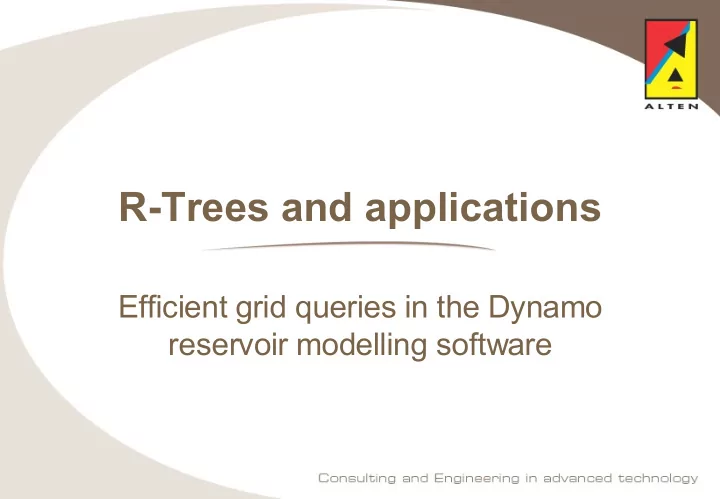

R-Trees and applications Efficient grid queries in the Dynamo reservoir modelling software
R-Tree Project A.N. Yzelman (UU) Supervisors A.N. Swart (Alten) G.L.G. Sleijpen (UU) Project Owners Eric Haesen (Alten) Hans Molenaar (Shell)
Overview • Problem: Querying large spatial databases. • Application in Dynamo reservoir simulation software. • R-Trees. - Example - Testing - Implementation
Querying spatial data • Needed in areas of: 1. Image processing (Ray-tracing / CAD) 2. Geographical information systems (e.g., TomTom) 3. Robotics
Example The San Francisco road network
Typical Queries • Containment “What objects are contained in ...” • Neighbours “What objects are close to...” • Intersection “What objects cross...”
The Naive Approach -> Test all objects May take enormous amount of time: 174599 nodes for San Francisco Map Conclusion: need a clever data structure
Trees Example: Binary Search tree Each node has max. two children
Trees • Searching takes O(log(n)) time (2048 entries take twice the time of 1024 entries!) • Insertion/Deletion may be slower Main issue for spatial data: need an ordering
Dynamo • Dynamo uses high resolution grids • Queries: neighbours, intersections, overlap • Currently uses a bisection method, which may be sub-optimal Dynamo may benefit from a custum taylored R-Tree implementation
Example Grid
R-Trees • Consider a simple two-dimensional case:
R-Trees • Add Bounding Boxes
R-Trees • Add Bounding Boxes
R-Trees • Add Bounding Boxes
R-Trees • Add Bounding Boxes
R-Trees • Add Bounding Boxes
R-Trees • Add Bounding Boxes
R-Tree Properties • Every node contains between m and M data elements unless it is the root. • All leaves appear at the same level, and contain all the data elements. • The bounding boxes used tightly encloses the objects within.
R-Tree Properties • Every node contains between m and M data elements unless it is the root. m and M may be chosen with memory or disk cache size in mind. In the latter case, R-trees reduce to the well known B-trees.
Subtleties • By the previous example, an R-tree can be built in many different ways.
R-Trees
Variants • By the previous example, we saw an R- tree can be built in many different ways. • Leads to many different R-tree variations.
Variants • By the previous example, we saw an R- tree can be built in many different ways. • Leads to many different R-tree variations. • For example: R*-tree, PR-tree, Hilbert-tree, R+-tree, and more...
Testing • Use real life geographical data supplied by Shell. • Test several R-tree variations. • Tune tree parameters to the specifics of Shell data. • Quantify results in terms of query time, memory usage and query response quality.
Implementation • Object-Oriented C++ • Easily extended • “Plug & Play” solution for spatial data storage • Generic design targeted at n -dimensional polygons in different spaces
Questions?
Recommend
More recommend